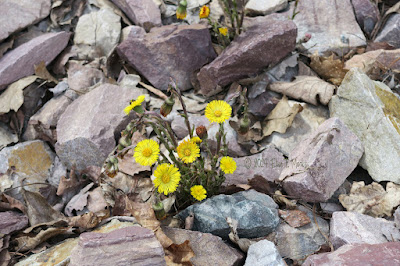
Purple Hepatica
Spring Woodland Flowers
in Essex, Vt.
Liver leaf. Extracts or decoctions made from the leaves have been used in herbal medicine for the treatment of liver ailments, gallbladder ailments and digestive disorders, and to treat coughing and bronchitis. Although poisonous in large doses, the leaves and flowers may be used as an astringent, as a demulcent for slow-healing injuries, and as a diuretic.
Trout Lily In Bloom
and a Trillium about to open.
Erythronium americanum Ker Gawl. Yellow Trout-lily, American Trout-lily, Eastern Trout-lily, Yellow Dogtooth Violet, Adder's Tongue. Liliaceae (Lily Family)
You will find this flower in sizable colonies with plants bearing a single, nodding, yellow flower. Non-flowering plants also occur which are either too young or too crowded to flower. Flowers are critical sources of pollen and nectar for early-season pollinators. Just like bloodroot, trout lily seeds are dispersed by ants.
Houstonia caerulea L.
Azure Bluet, Quaker Ladies, Bluets
The Cherokee used an infusion of little bluet as a cure for bedwetting.
Bluets
Bellwort
LARGEFLOWER BELLWORT
(UVULARIA GRANDIFLORA)
Red Trillium
Here's why...
1. It takes 9 years after germination for a trillium to flower.
2. Each flower yields only ONE seed pod each year.
3. Each plant can live up to 25 years, and gains all of its nourishment for the remainder of the year during the spring when its leaves are present.
4. Trillium are propagated by ANTS. Not bees, the wind or birds. The seeds are covered by a sweet coating, which entices the ants to carry seeds underground into their colonies. After eating the coating, the seed germinates in the perfect subterranean environment.
Every trillium in the forest is essentially a miracle.
(Sanguinaria canadensis). Bloodroot's name is derived from the color of the reddish roots. The red juice from the root is used externally in pastes and salves to remove warts, skin tags, and some skin cancers, and it has shown anti-cancer and anti-inflammatory properties. Sustainable cultivation of S. canadensis is incredibly important as demand for the plant increases, but almost all Bloodroot sold commercially is wild harvested. Please make sure all Bloodroot you acquire has been cultivated, or use alternative medicinal species. Should be used with caution.
Canada wild ginger is found in rich, moist forests in much of New England. This early spring wildflower not realizing that it has an interesting and peculiar flower underneath the canopy of its heart-shaped leaves. It is unrelated to the ginger commonly used in cooking, but the root has a strong, ginger-like flavor. Native Americans used it in cooking and to treat a wide variety of maladies, including coughs, colds, stomach pains, and poor digestion. Fresh or dried roots were used by early Americans as a ginger substitute, but the plant is not normally used today for culinary purposes. However, be aware that the plants may contain toxic compounds and consumption of the plant is highly discouraged.
Hellebore Transformation,
This is what a white Hellebore looks like as it's changing to go to seed. Hellebore is native to much of Europe and is commonly found in early spring and shade gardens in North America as well. Hellebores look like members of the rose family but they are actually members of the buttercup family.
I love the shapes of the flowers, leaves, and the whole plant. I even love the nutty smell of the oil and tincture I make from the root. A good use for the extra one's growing in my garden. Culinary Uses (root & young shoots only.) Indigenous cultures of North America consumed the starchy rhizomes of Solomon's seal as a potato-like food to make breads and soups. The young shoots are also edible, raw or boiled for an asparagus-like food. Solomon's Seal has been used for centuries to heal wounds, repair damaged tissue, bruises, and knit broken bones; relieve dry coughs and tuberculosis; treat chronic dysentery, diarrhea and hemorrhoids.
Starflower(Trientalis borealis Raf.)
A woodland wildflower. Even their shadows are cool.
THANKS FOR YOUR VISITS, FAVS AND COMMENTS. AS ALWAYS, APPRECIATED VERY MUCH!
© ALL RIGHTS RESERVED BY ELISE T. MARKS. PLEASE DO NOT USE THIS IMAGE ON WEBSITES, BLOGS OR ANY OTHER MEDIA WITHOUT MY EXPLICIT WRITTEN PERMISSION.MY PHOTOGRAPHS ARE AVAILABLE FOR PURCHASE THROUGH ELISECREATIONS.NET
MY PHOTOGRAPHS ARE AVAILABLE FOR PURCHASE THROUGH ELISECREATIONS.NET









































































